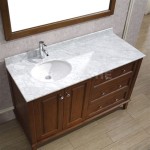How To Paint a Bathroom Vanity Top: A Comprehensive Guide
Painting a bathroom vanity top is a cost-effective way to refresh the look of a bathroom without the expense of a full replacement. This process allows for customization of color and finish to align with evolving design preferences. A successful paint job requires careful preparation, appropriate materials, and meticulous application. This guide outlines the necessary steps for achieving a durable and aesthetically pleasing painted vanity top.
Key Considerations Before Painting
Before commencing any painting project, it is essential to evaluate the existing vanity top's material and condition. Laminate, cultured marble, solid surface acrylics, and even certain types of tile can be successfully painted. However, natural stone like granite or marble may not be suitable for painting due to their porous nature and the potential for paint adhesion issues. Assess the surface for any existing damage, such as chips, cracks, or stains, as these will need to be addressed prior to painting.
The type of paint selected is crucial for durability and longevity in the moisture-rich bathroom environment. Epoxy-based paints and specialized countertop paints are generally recommended due to their enhanced resistance to water, stains, and everyday wear and tear. Consider the desired finish, such as matte, satin, or gloss, as this will impact the overall aesthetic of the bathroom. In addition to paint, essential supplies include sandpaper (various grits), primer (specifically designed for the vanity top material), cleaning solutions, painter's tape, drop cloths, paintbrushes, rollers (foam rollers are often preferred for smooth surfaces), and safety equipment.
Proper ventilation is paramount when working with paints and solvents. Ensure the bathroom is well-ventilated by opening windows and using a fan to circulate air. Wearing a respirator mask is recommended to avoid inhaling harmful fumes. Eye protection, such as safety glasses, is also advisable to prevent paint splatters from entering the eyes. Protective gloves will safeguard hands from paint and cleaning solutions.
Step-by-Step Preparation Process
The surface preparation process is arguably the most critical step in achieving a successful and long-lasting paint finish. Inadequate preparation will likely result in paint chipping, peeling, or an uneven appearance.
Begin by thoroughly cleaning the vanity top with a grease-cutting cleaner to remove any soap scum, grime, or residue. For particularly stubborn stains or buildup, a scrub brush may be required. Rinse the surface thoroughly with clean water and allow it to dry completely. Once dry, inspect the surface for any remaining contaminants and repeat the cleaning process if necessary.
Sanding the vanity top is essential for creating a slightly rough surface that allows the primer and paint to adhere properly. Start with a coarser grit sandpaper (around 120-grit) to scuff the existing surface. For smoother surfaces like laminate, a finer grit (around 220-grit) may suffice. Sand evenly, applying consistent pressure to avoid creating uneven patches. The goal is not to remove the existing finish entirely, but rather to create a "tooth" for the primer to grip onto. After sanding, thoroughly wipe down the surface with a tack cloth to remove any sanding dust. This step is crucial, as any remaining dust particles will compromise the paint's adhesion and create a bumpy finish.
Repair any existing damage, such as chips, cracks, or dents, before proceeding with priming and painting. Use a suitable filler or epoxy compound designed for the vanity top material. Apply the filler according to the manufacturer's instructions, ensuring it is properly cured and hardened before sanding it smooth. Use fine-grit sandpaper to blend the repaired areas seamlessly with the surrounding surface. Again, remove all sanding dust with a tack cloth.
Protect surrounding surfaces from paint splatters by applying painter's tape to edges, fixtures, and walls. Use a high-quality painter's tape to ensure clean lines and prevent paint bleed-through. Cover the sink basin and surrounding areas with drop cloths to catch any drips or splatters. This step will save considerable time and effort in cleaning up after the painting process.
Priming the vanity top is an essential step that enhances paint adhesion, blocks stains, and creates a uniform surface for the paint to adhere to. Choose a primer specifically designed for the vanity top material, such as a bonding primer for laminate or a stain-blocking primer for previously stained surfaces. Apply the primer in thin, even coats using a high-quality paintbrush or foam roller. Allow each coat of primer to dry completely according to the manufacturer's instructions before applying the next coat. Two coats of primer are typically recommended for optimal results. Lightly sand the primed surface with fine-grit sandpaper (around 320-grit) to smooth out any imperfections before applying the paint. Again, remove all sanding dust with a tack cloth.
The Painting Process and Achieving a Durable Finish
With the preparation complete, the painting process can begin. Choose a high-quality paint designed for bathroom environments, such as an epoxy-based paint or a specialized countertop paint. These paints offer superior durability, moisture resistance, and stain resistance compared to standard latex paints.
Apply the paint in thin, even coats using a high-quality paintbrush or foam roller. Avoid applying the paint too thickly, as this can lead to drips, runs, and an uneven finish. Apply each coat in long, smooth strokes, overlapping each stroke slightly to ensure complete coverage. Allow each coat of paint to dry completely according to the manufacturer's instructions before applying the next coat. Multiple thin coats are preferable to one thick coat, as this will result in a more durable and aesthetically pleasing finish.
Lightly sand the painted surface with very fine-grit sandpaper (around 400-grit) between coats to smooth out any imperfections or brushstrokes. This step is particularly important when using high-gloss paints, as imperfections will be more noticeable. Remove all sanding dust with a tack cloth before applying the next coat of paint.
Apply at least two coats of paint for optimal coverage and durability. For high-traffic areas or for a more durable finish, consider applying a clear topcoat specifically designed for countertops. A clear topcoat will provide added protection against scratches, stains, and water damage. Apply the topcoat in thin, even coats according to the manufacturer's instructions, allowing each coat to dry completely before applying the next.
Once the final coat of paint or topcoat is completely dry, carefully remove the painter's tape. Use a utility knife or razor blade to score along the edge of the tape before removing it to prevent the paint from peeling. Allow the painted vanity top to cure completely for several days before placing any items on it or exposing it to water. Curing is essential for the paint to harden and develop its full durability.
Clean paintbrushes and rollers thoroughly with the appropriate solvent immediately after use. Proper cleaning will extend the life of paint tools and ensure they are ready for future painting projects. Dispose of used paint, cleaning solutions, and other materials according to local regulations.
After the painted vanity top has fully cured, inspect it carefully for any imperfections or areas that require touch-ups. Use a small brush to apply touch-up paint to any areas that are chipped, scratched, or uneven. Allow the touch-up paint to dry completely. Clean the painted vanity top regularly with mild soap and water. Avoid using abrasive cleaners or harsh chemicals, as these can damage the paint finish. Use coasters or mats to protect the painted surface from hot items or spills. With proper care and maintenance, a painted bathroom vanity top can provide years of beauty and functionality.

Paint Bathroom Vanity Countertop Sink So Easy A Piece Of Rainbow

How To Easily Spray Paint Bathroom Countertops My Homier Home

Paint Bathroom Vanity Countertop Sink So Easy A Piece Of Rainbow

How To Paint A Countertop Don T Make These Mistakes Blessed Beyond Crazy
:strip_icc()/101922779-2cbc45e123c34827afb4f601723b03ca.jpg?strip=all)
How To Paint Bathroom Countertops

Paint Bathroom Vanity Countertop Sink So Easy A Piece Of Rainbow

How To Paint A Countertop Don T Make These Mistakes Blessed Beyond Crazy

How To Easily Spray Paint Bathroom Countertops My Homier Home

How To Paint Tile Countertops And Our Modern Bathroom Reveal Bright Green Door
.jpg?strip=all)
Painting A Bathroom Vanity Again Dream Green Diy







